|
|
|
|
Products mentioned in this Article
--None--
|
|
|
|
|
|
|
|
|
 |
|
|
|
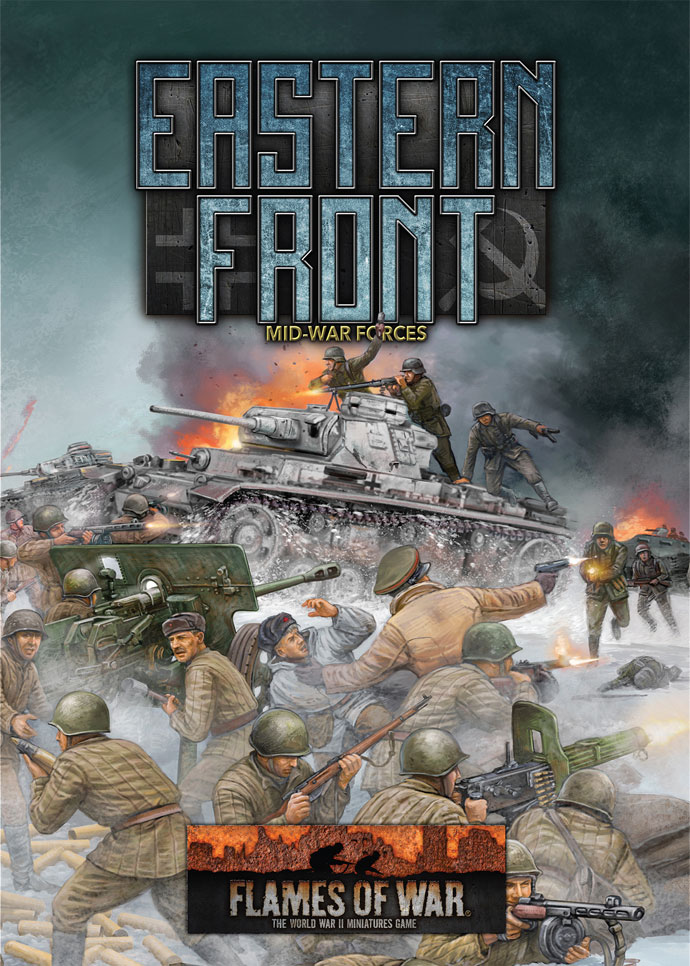
|
Eastern Front: Mid-war Forces Spotlight
with Phil Yates
The new Eastern Front compilation is about to do for the Russian Front what North Africa did for the war in Africa. Between the new compilation and the accompanying starter and army sets, re-fighting epic mid-war battles like Stalingrad and Kursk have never been easier.
Whether you are returning to the Mid-War period or starting from scratch, the Eastern Front book has everything you need in one package. Eastern Front compiles all the existing Mid-War books for the fighting in Russia
Eastern Front: Mid War Forces Spotlight...
|
 |
|
Stalingrad: Complete World War II Starter Set (FWBX13)
Despite being driven back from the gates of Moscow in the winter offensive, the Germans advanced again in the summer of 1942. The Red Army launched attack after attack to throw the invaders back, but nothing could stop them from overrunning southern Russia and reaching the Volga River at Stalingrad. In the bitter street fighting of autumn, the Red Army bled the Germans white. Then, as winter set in, the Soviets launched another series of offensives that regained all that they had lost.
Stalingrad: Complete World War II Starter Set (FWBX13)...
|
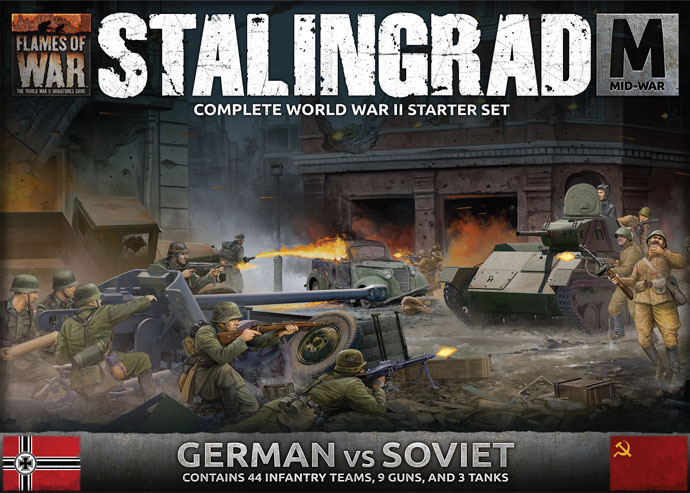
|
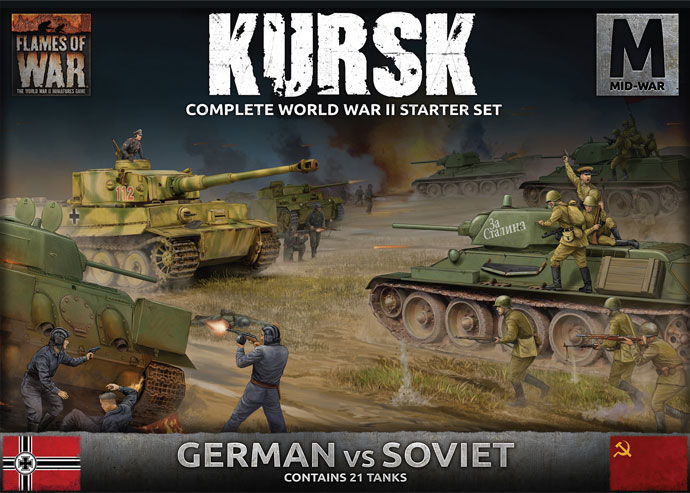 |
Kursk: Complete World War II Starter Set (FWBX14)
As the ground hardened after the muddy Russian Spring, the German army prepared to launch their Summer offensive, codenamed Operation Citadel. The target was Kursk, a city in the centre of a huge bulge in the front line, where several Soviet armies could be cut off and destroyed. To ensure success, new weapons were rushed to the front. These were combined with several panzer divisions, totalling an impressive 2450 tanks. Over 3600 Soviet tanks were waiting for them, setting the scene for the largest tank battle on the Eastern Front...
Kursk: Complete World War II Starter Set (FWBX14)...
|
|
Soviet T-34 Tank Company (SUAB15)
The robust T-34 suited the Red Army. It was simple to make, forgiving of poor maintenance, and easy to repair — plus, there were many more rolling out of the factories to replace those that could not be repaired. The latest versions made it much easier for the commander to command while doing their other job as gunner, making the individual tanks faster, and the formations more flexible.
Soviet T-34 Tank Company( SUAB15)...
|
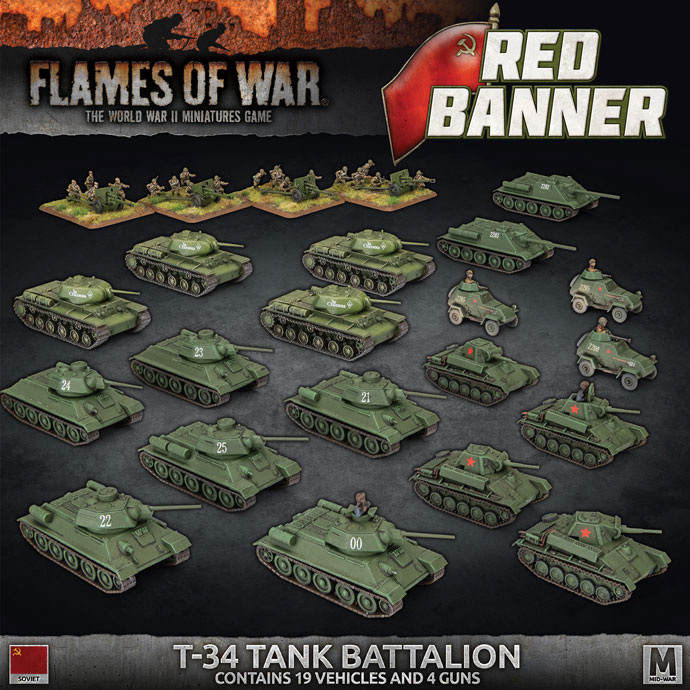
|
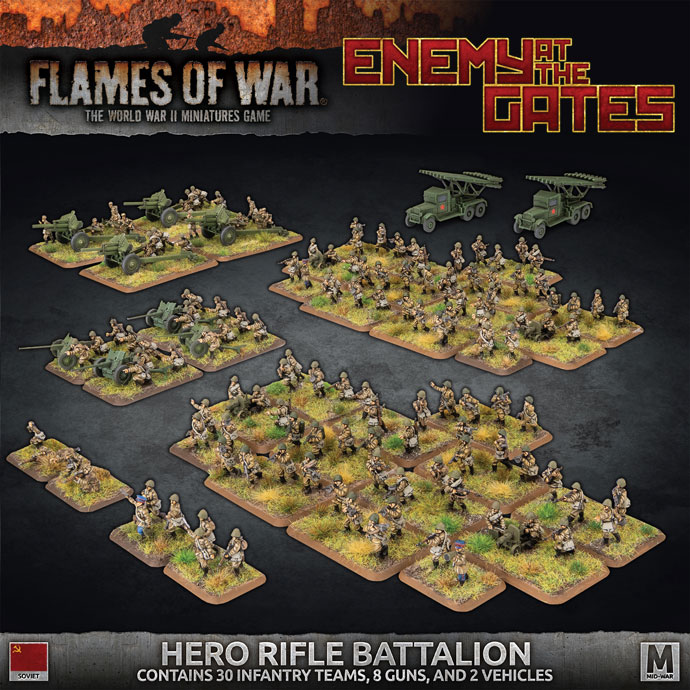 |
Enemy at the Gates Hero Rifle Battalion (SUAB14)
After a few days of battle, rifle battalions would be reduced to the strength of a weak company. While this reduced their theoretical combat power, the survivors were hardened by their experience in the furnace of battle, and had learned how to fight and stay alive. Having learned the cost of headlong charges and the value of keeping their troops alive, experienced battalion commanders allow their troops more latitude in how they fight.
Enemy at the Gates Hero Rifle Battalion (SUAB14)...
|
|
German Mixed Panzer Company (GEAB24)
In 1943, the Ghost Division participated in the Battle of Kursk as a part of the 48th Panzer Corps on the southern pincer attack. For the attack, the division had received new models of Panzer III and IV tanks with additional armour and better weapons, and new Flammpanzer III tanks. The division’s infantry was also fitted with new armoured half-tracks and self-propelled guns to give them additional firepower.
German Mixed Panzer Company (GEAB24)...
|
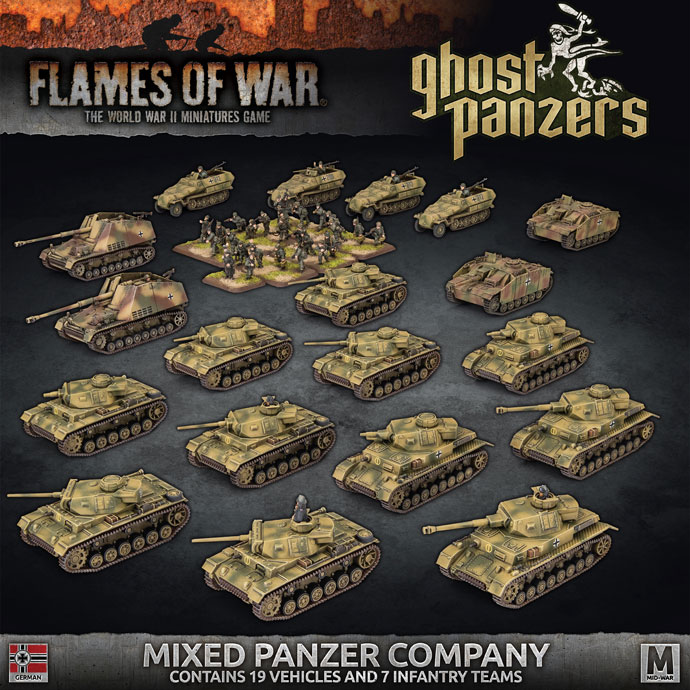
|
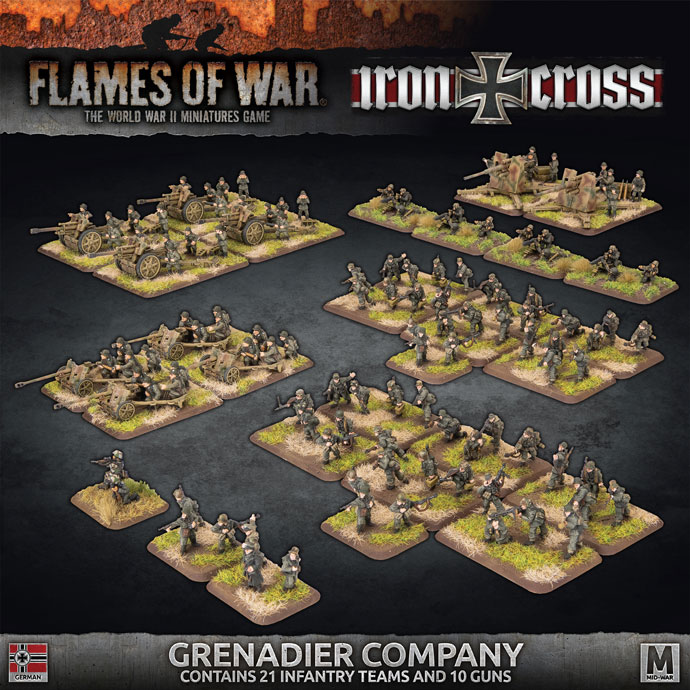 |
German Grenadier Company (GEAB23)
At the start of the Germans' first assault on Stalingrad on 13 September, the division drove into the heart of the city. The Luftwaffe's bombing campaign had turned most of the city to rubble, and the 295th soon found itself embroiled in vicious house-to-house fighting. Their main objective was the well-defended Mamayev Kurgan, a massive hill in the middle of the city that provided an ideal vantage point for artillery spotting and for directing the battle. It was highly valued by both Soviet and German forces, ensuring the fight for it would be a bloody one. The 295th eventually took the summit, but were relentlessly subjected to Soviet sniper fire and counterattacks from the northern and eastern slopes of the hill. The fighting was savage, as the infantrymen fought with bayonet, grenade, and flamethrower to make any headway against a determined enemy.
German Grenadier Company (GEAB23)...
|
|
Dicker Max Tank-Hunter Platoon (GBX190)
While still fighting in Poland in September 1939, the German High Command looked ahead to the coming battle with France and ordered a vehicle for use against the fortifications of the Maginot Line. In response, Krupp set about designing a self-propelled 10.5cm gun based on a Panzer IV tank chassis. The new vehicle’s rotund profile quickly gained it the nickname ‘Dicker Max’ (‘Fat Max’).The two prototypes were assigned to the 521st Heavy Tank-hunter Battalion for a planned attack on Gibraltar. When this was cancelled, they were assigned to the 3rd Panzer Division for Operation Barbarossa, the invasion of the Soviet Union. One Dicker Max was lost in an ammunition explosion and the other returned to the factory in October 1941 after three months in combat.
Dicker Max Tank-Hunter Platoon (GBX190)...
|
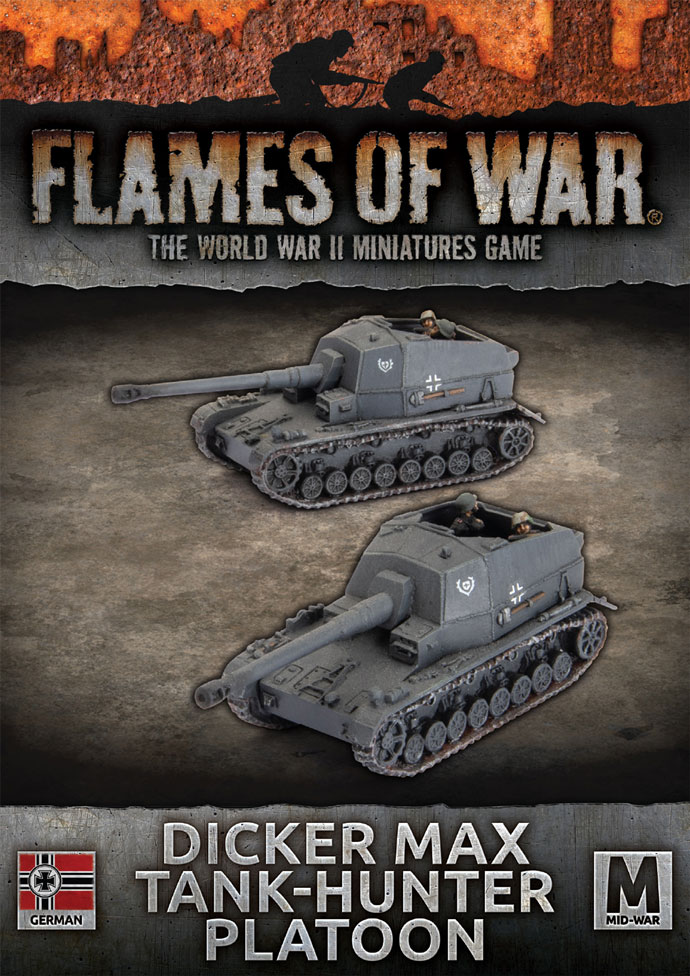
|
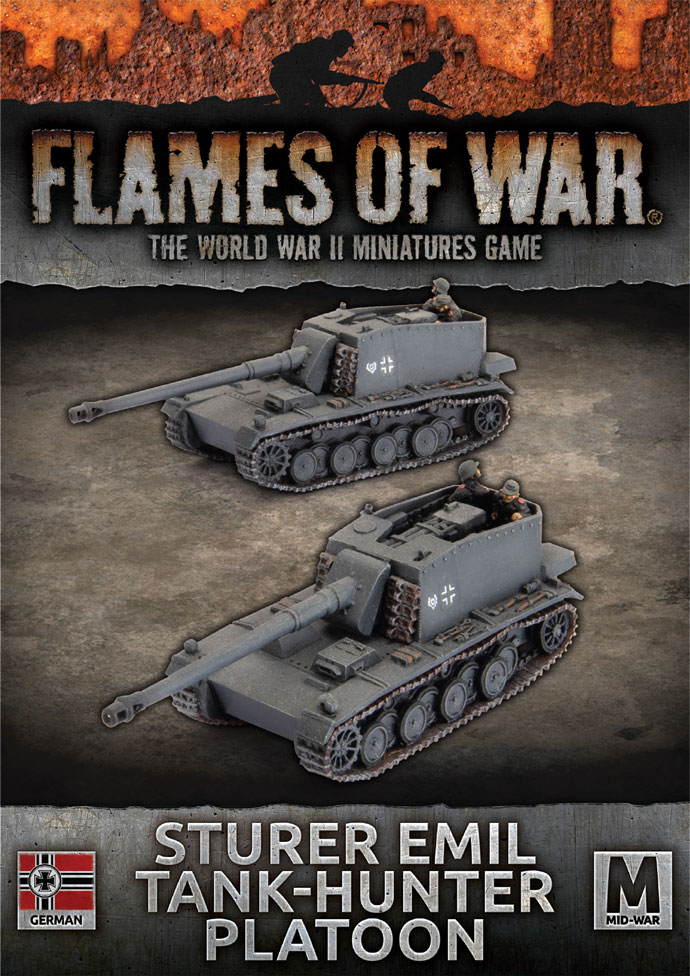 |
Sturer Emil Tank-hunter Platoon (GBX191)
includes two Sturer Emil Tank-hunters and two Unit Cards.
The 12.8 cm Selbstfahrlafette L/61 (12.8cm L/61 Self-propelled Mounting) or Panzerselbstlafette V (Armoured Self-propelled Mounting Mark 5) was armed with a huge Rheinmetall 12.8 cm gun based on the gigantic 12.8 cm FlaK 40. With such cumbersome designations, it quickly gained the unofficial nickname of ‘Sturer Emil’ (Stubborn Emil). The two vehicles were named Max and Moritz after the naughty boys in Busch’s famous German children’s tale.
Check out the Sturer Emil Tank-hunter Platoon in the online store here...
|
|
8.8cm Bunkerflak Tank-hunter Platoon (GBX187)
includes two 8.8cm (Sfl) (8.8cm) Tank-hunters and two Unit Cards.
The 8.8cm Bunkerflak SP guns were issued to the 8th Heavy Tank-hunter Battalion. They fought in Poland in 1939 and then France in 1940, supporting the 1st and 2nd Panzer Divisions. They engaged French tanks (including the heavy Char B) on several occasions, losing two vehicles in the process. The 8th Heavy Tank-hunter Battalion was attached to the 39th Army Corps for the invasion of Russia in 1941. Then, in mid-1942, the four surviving vehicles joined the 521st Heavy Tank-hunter Battalion, fighting in the Caucasus alongside the last surviving Dicker Max and the two Sturer Emil heavy tank-hunters
Check out the 8.8cm Bunkerflak Tank-hunter Platoon in the online store here...
|
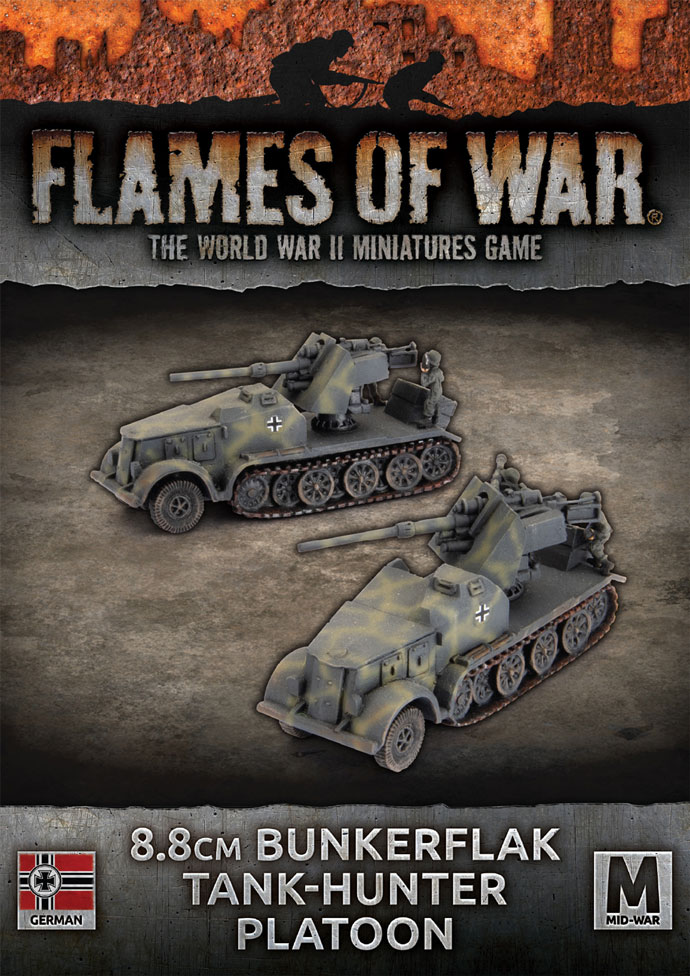
|
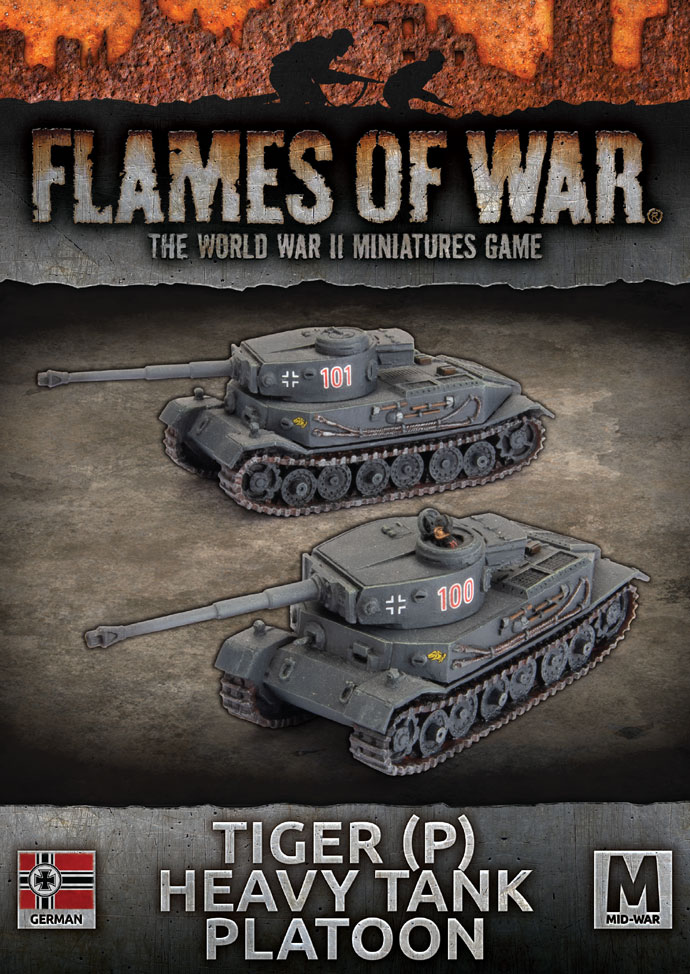 |
Tiger (P) Heavy Tank Platoon (GBX189)
includes two Tiger (P) (8,8cm) Tanks.
The Tiger (P) was scheduled to be sent to Africa where their air-cooled engines were seen as better suited to the hot and dusty conditions. If their electric transmissions had worked, the first five Tiger (P) tanks would have arrived in Africa as the Second Battle of El Alamein began. Like the Henschel-designed Tiger, Porsche's Tiger (P) mounted the deadly '88', equally capable against tanks, guns, and dug-in infantry. The Tiger (P) used a sophisticated petrol-electric transmission. This gave it an incredible ability to go almost anywhere. However, it was somewhat unreliable, limiting the practical top speed.
Check out the Tiger (P) Heavy Tank Platoon in the online store here...
|
|
Panzer I Infantry Tank Platoon (GBX188)
includes two Panzer I (MG) Tanks and two Unit Cards.
Based on the Panzer I, the VK1801 featured torsion bar suspension, interleaved road wheels, and an up-rated engine with 50% more power. The commander’s turret replaced the old MG13 machine-guns with the latest MG34 machine-guns and featured a cupola with five periscopes for all-round vision. All-in-all it was a magnificent piece of engineering, it weighed as much as a medium tank and cost nearly as much to produce!
Check out the Panzer I Infantry Tank Platoon in the online store here...
|
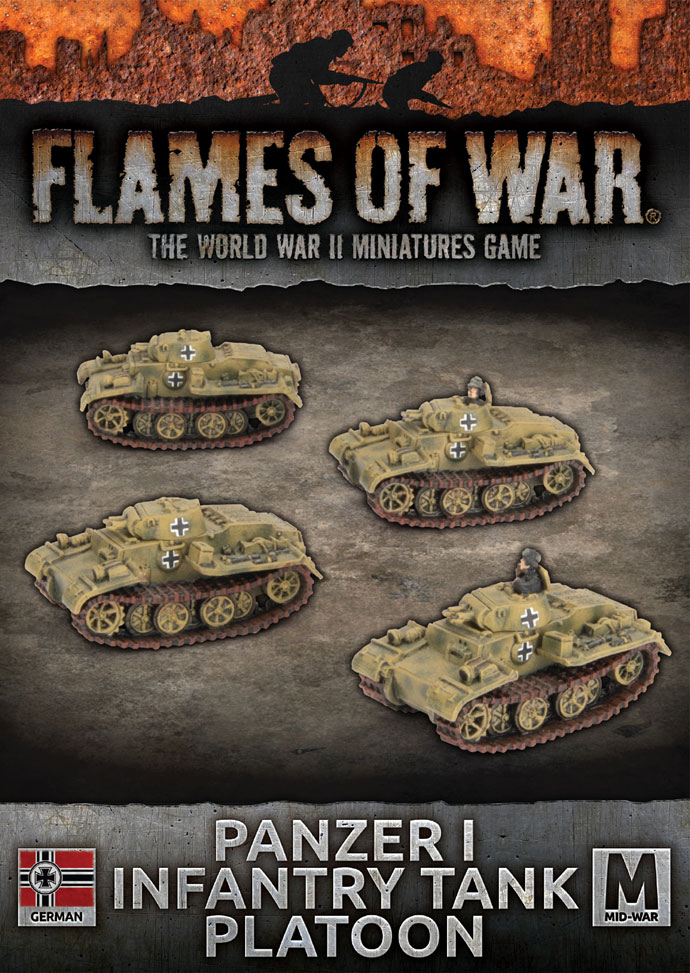
|
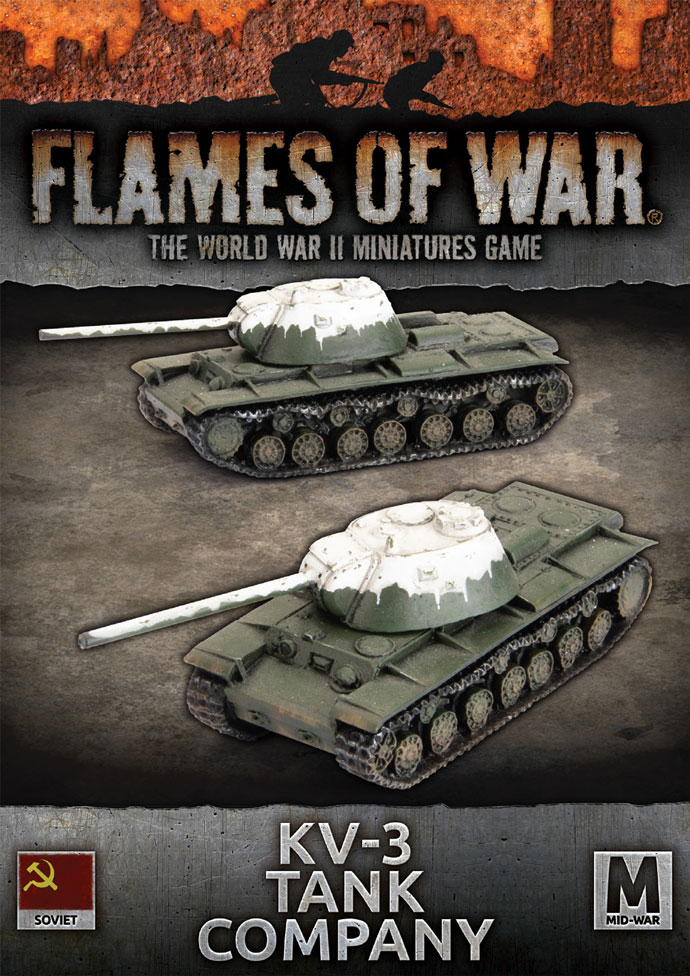 |
KV-3 Tank Company (SBX82)
includes two KV-3 Tanks and three Unit Cards.
With Leningrad surrounded, the ambitious production plan for the KV-3 heavy tank was curtailed until a new plant could be established in the Tankograd complex in the Urals. If the plan had not been changed, production of the KV-3 could have finally got under way in 1942. The first KV-3 tanks would have been ready for the Summer offensives. With their over-taxed supercharged engines, there were likely to have been technical problems at the beginning. However, by the time of Operation Uranus, the battle to surround Stalingrad, their could have been many more of them in place of the KV-1s that actually fought there.
Check out the KV-3 Tank Company in the online store here...
|
|
T-43 Hero Tank Company (SBX72)
includes two T-43 (76mm)Tanks and three Unit Cards.
To combat the new German anti-tank weapons, the T-43 medium tank has the armour of a heavy tank, while retaining the speed of the original. The first two prototypes were finally completed in March 1943 and went through trials in August. As a result, the T-43 was recommended for production to replace the T-34. They could have been in combat in significant numbers by the end of the year. However, the appearance of large numbers of German heavy Tiger, Panther and Ferdinand tanks at Kursk highlighted that a bigger gun was more important than heavier armour. As the T-43 was already at its weight limit, the T-43 turret, re-armed with a long 85mm gun, was fitted to the T-34, while the T-43 was redeveloped into the T-44.
Check out the T-43 Tank Company in the online store here...
|
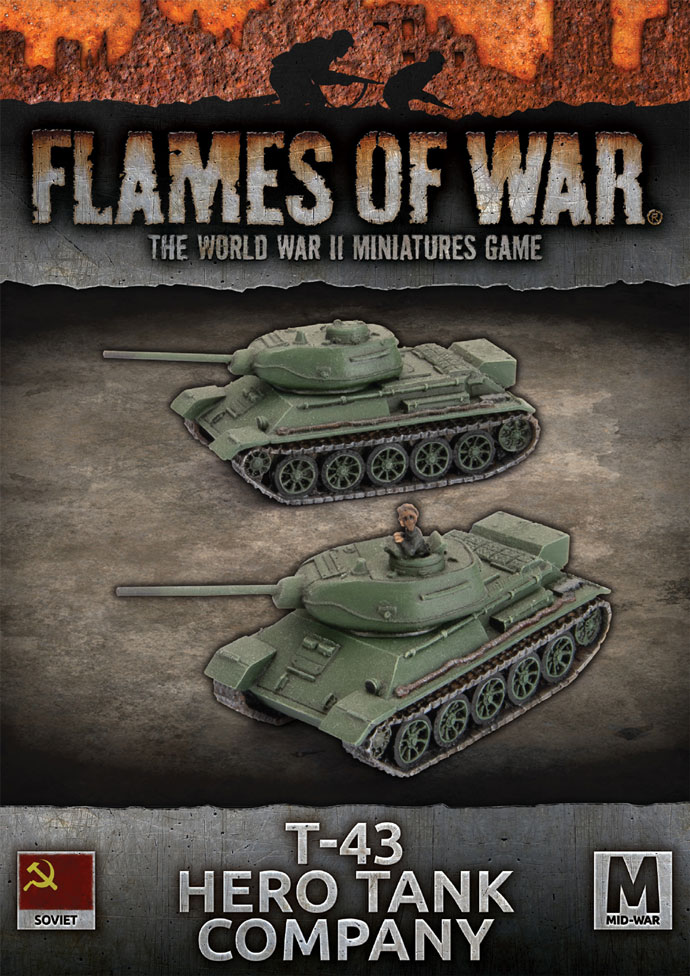
|
|
KV-5 Tank Company (SBX83)
includes two KV-5 Tanks and two Unit Cards.
The design of the KV-5 was almost complete by August 1941 and production of the prototype had begun when the approaching German Army forced the design team to evacuate to the Urals. The proposed tank was huge, and weighed 100 tons.The crew of six had plenty of room, but they were widely separated. Both the driver-mechanic and the radio operator/machine-gunner had separate compartments, the driver with their own vision cupola, and the machine-gunner with a rotating machine-gun cupola. The turret was large for its four man crew, with machine-gun cupola on top manned by one of the two loaders.
Check out the KV-5 Tank Company in the online store here...
|
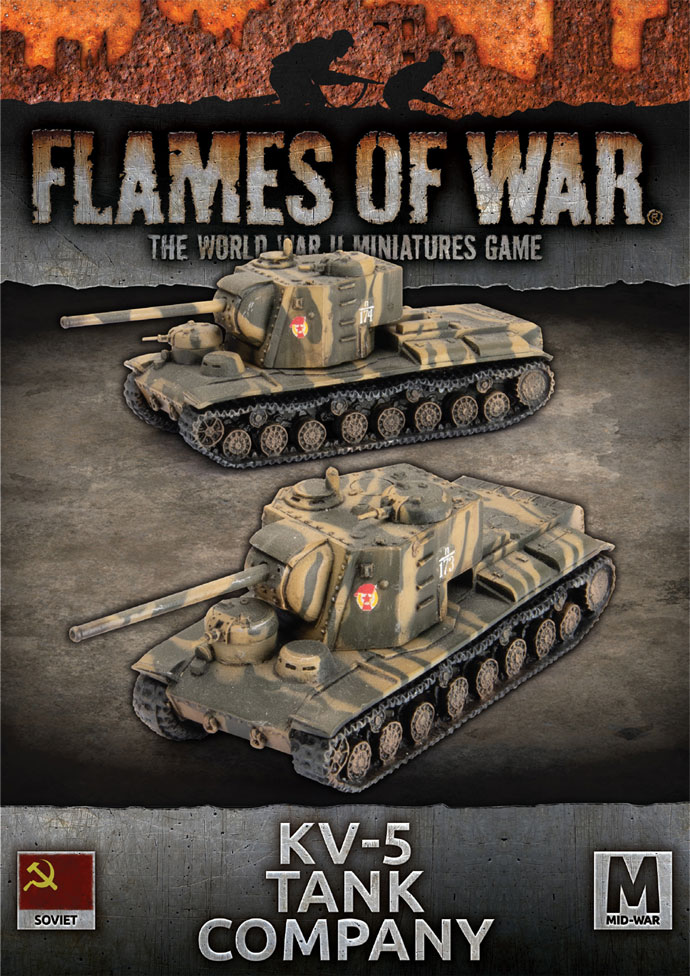
|
|
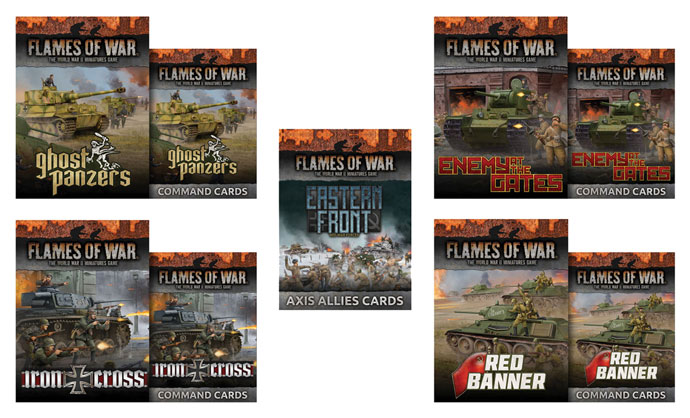
|
Eastern Front: Mid-war Cards Packs
These packs contain a Unit Card pack containing one of each Unit Card that relates to their book, and a Command Card pack that allow Flames Of War generals to field iconic warriors, build new types of units, field new types of equipment, enhance your commander’s capabilities, and bring new tactics and stratagems to the battlefield.
Eastern Front: Mid-war Cards Packs...
|
|
|
Eastern Front Gaming Sets
Even though they are toy soldiers, your troops react to heavy fire like real soldiers. Sometimes they get pinned down or bail out of their tanks. They can dig foxholes for protection or go to ground, hiding from the enemy. Tokens help you keep track of the state of your troops.Each Gaming Set contains 20 gaming tokens, 16 Dice and two Objective tokens all inside a collectable themed tin.
|
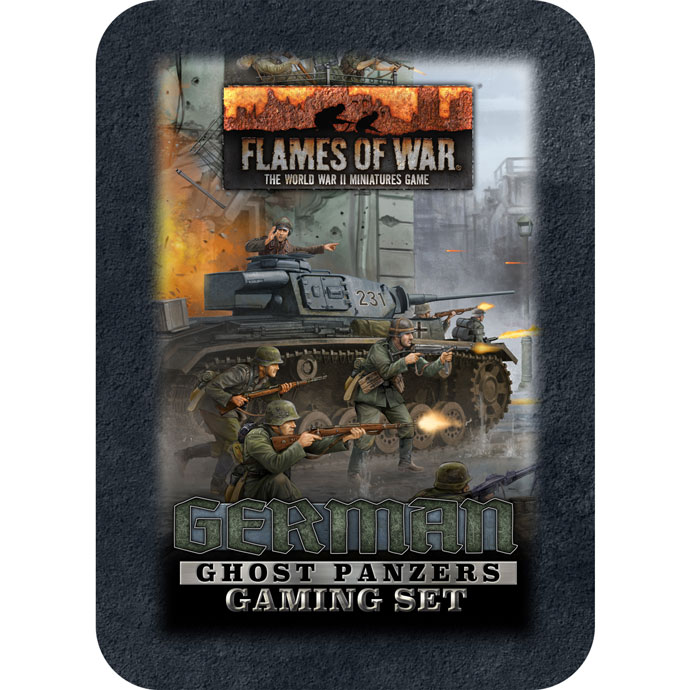 |
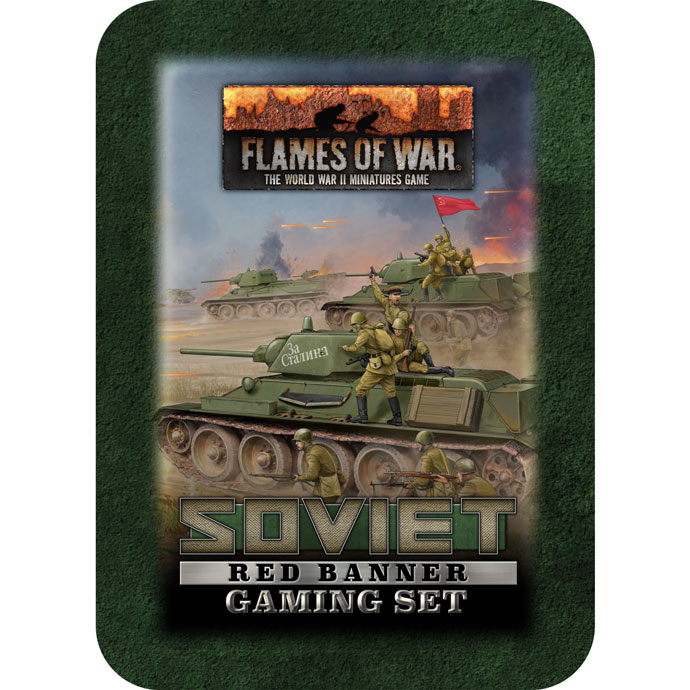
|
|
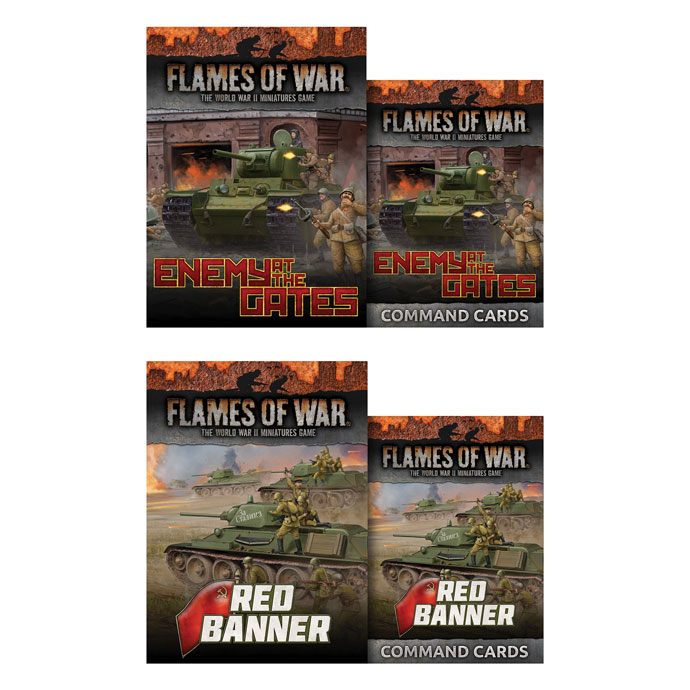
|
Soviet Command Cards
With Livio Tonazzo
The new Eastern Front book see the release of the Command Cards that we had already had the opportunity to appreciate in past years. Naturally, these are two collections, Enemy at the Gates, centered on the heroic defense of Stalingrad, and Red Banner, centered on the battle of Kursk.In this article we will review them by dedicating more attention to those Command Cards that are particularly performing in terms of play.
Soviet Command Cards...
|
|
Command Card Formations
With John Lee
When V4 of Flames of War released, alongside the books were Unit Cards and Command Cards – this was new for the game. The Unit Cards have all the stats as in the book and rules for that unit which meant you could refer to them more easily in the game, rather than having to flick through different sections of the Army book. The addition of the command cards allowed the army book to be streamlined with the core formations and units whilst the specialising, upgrading, downgrading, warriors and non-standard formations and units moved to the new card pack.
Axis Allies Command Card Formations...
German Command Card Formations...
|
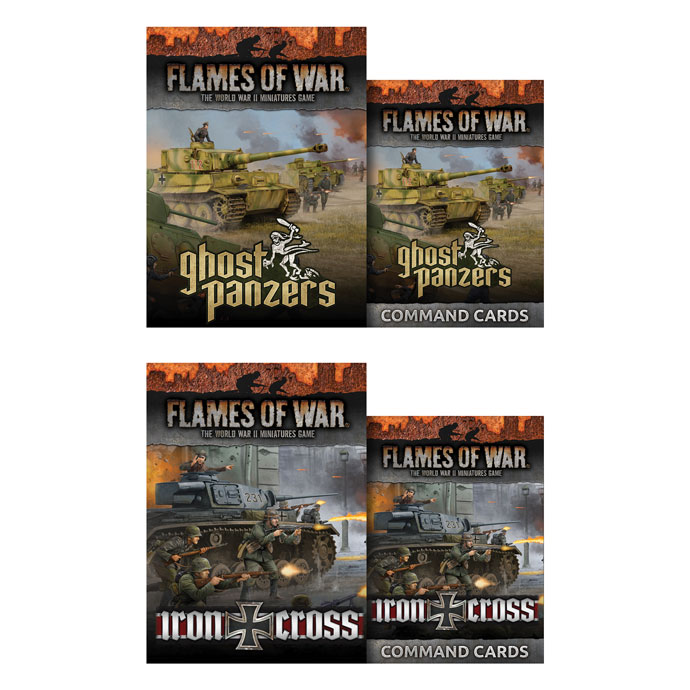
|
|
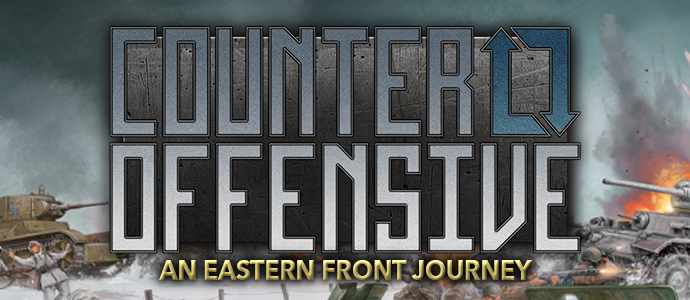 |
|
For the release of Eastern Front we are showcasing the new starter sets with Luke and Ryan as they take the dive into the Eastern Front with the brand new starter boxes. The eastern front in mid-war is home to some of the most historical pivotal moments of World War II. Kursk and Stalingrad are two major battlefields where counter offensives changed the course of the war to decide the fate of Europe and hence the names of our new starter boxes.
Join us over the coming weeks in Counter Offensive: An Eastern Front Journey as we update this page and our social media with videos and images as they prepare forces for and battle on the eastern front of Flames Of War.
Counter Offensive: An Eastern Front Journey Landing Page...
|
|
Last Updated On Friday, March 1, 2024 by Kevin
|
|
|